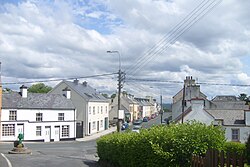Mountcharles
| Mountcharles Irish: Tamhnach an tSalainn | |
| County Donegal | |
|---|---|
 Mountcharles | |
| Location | |
| Grid reference: | G871780 |
| Location: | 54°39’-0"N, 8°12’-0"W |
| Data | |
| Population: | 484 (2016) |
| Local Government | |
| Dáil constituency: |
Donegal |
Mountcharles is a townland (of 650 acres) and a village in the south of County Donegal, four miles from Donegal Town on the Killybegs road (the N56), in the Barony of Banagh.[1] The village's name is usually pronounced locally as 'Mount-char-liss'.
Name
Before the Plantation of Ulster, the area from the present road to the sea, including modern day Salthill, was known as Tamhnach an tSalainn ('the Field of Salt'). This refers to the fields along the coast which flooded with seawater with the flow of the tide, as the water receded, salt remnants remained in the fields.
The Irish name for the village refers to this salt mine in the area which local people worked in, and at a growing rate, as the salt extraction rate was increased by the plantation founder, Charles Conyngham. The name was later anglicized as Tawnaghtallan and Tawnytallan.[2]
The Cistercian Grange in the area was known as the Grange of Tawnytallon which led to the area being anglicised as Tawnaghtallan and Tawnytallan.[2]
The current name for the village owes its origin to the investor ('undertaker') Charles Conyngham, who arrived in County Donegal during the Plantation of Ulster and asserted a landlord control over the area, renaming the region Mount Charles after himself.[3] By controlling the sale of salt from the region, Charles Conyngham then financed the building of the few surviving buildings in the village in the 17th century. The Conyngham estate and its large estate house (Hall Demesne), close to the village, are now unoccupied. The courtesy title of the heir apparent of The Marquess Conyngham is Earl of Mount Charles, being named after the village.
The original Charles Conyngham is the ancestor of The 8th Marquess Conyngham (frequently known as 'Lord Henry Mountcharles') of Slane Castle, Meath.
An alternative origin for the modern name, Mountcharles, is from the 1660s. Albert Conyngham, son of Rev. Alexander Conyngham (Dean of Raphoe), was knighted by Charles II in 1666, and, in honour of the king, the plantation founders, the Conyngham's enforced the name change to Mountcharles.
History
In 1611, at the start of the Plantation of Ulster, The Rev. Alexander Conyngham, first Church of Ireland Rector of Inver and Killymard, took ownership over the area, designating the area near the present Hall House as his own.[4]
The village of Mountcharles was controlled by the Conyngham family thereafter.[5] In 1676 Mountcharles was granted the sole right to hold markets and fairs: "Mountcharles, alias Tounytallon, a Friday market and four fairs on the 19th May, 11th September, 11th November and 17th March. Pursuant to patent signed and dated at Whitehall 9th December 1675 – granted to Sir Albert Conyngham, Kt. – July 27th 1676".[6] The courtesy title of the heir apparent of Marquess Conyngham|The Marquess Conyngham is Earl of Mount Charles, is named after the village.
Arthur Young, noted agriculturist and social and political observer, mentioned visiting Mountcharles in his book A Tour of Ireland (1776-1779).[7]
Pre-Famine Mountcharles
The early houses were built with stone, which was quarried near St. Peter’s Lough and at the quarries behind the town. The early houses were thatched. According to both the 1841 Census and Lewis’ Topographical Dictionary of Ireland, Mountcharles was the only town in the parish pre-Famine times.[8]
Hall Demesne
The former country house of the Conyngham family, The Hall, is nearby the village. From the beginning of the 18th century the Conynghams no longer regarded Mountcharles as their principal seat, but Slane. It was sold by The 6th Marquess Conyngham immediately after the Second World War, in 1946, to pay for the installation of electricity in Slane Castle, Meath.
Railway
Mountcharles railway station was on a branch line of the County Donegal Railways Joint Committee, a narrow gauge railway system. It was opened on 18 August 1893 and shut on 1 January 1960.[9]
Sport
- Gaelic games: Saint Naul's GSS
- Football: Eany Celtic F.C
- Rowing: Mountcharles Rowing Club, established in 2013
References
- ↑ "Mountcharles". http://www.thecore.com/seanruad/.
- ↑ 2.0 2.1 Mountcharles/Tamhnach an tSalainn: Placenames Database of Ireland
- ↑ TV Mountcharles: We Love Donegal
- ↑ Meehan, Helen (2005). Inver Parish in History. Mountcharles: Helen Meehan. pp. 446. ISBN 9780955175107.
- ↑ Meehan, Helen (1999). "The Conyngham's of Slane and Mountcharles". Donegal Annual 51.
- ↑ Meehan, Helen (1999). "The Conyngham's of Slane and Mountcharles". Donegal Annual 56.
- ↑ Young, Arthur. "A Tour in Ireland 1776-1779". https://www.gutenberg.org/files/22387/22387-h/22387-h.htm.
- ↑ Meehan, Helen (2005). Inver Parish in History. Mouncharles: Helen Meehan. pp. 447. ISBN 9780955175107.
- ↑ Irish Railways: Railscot